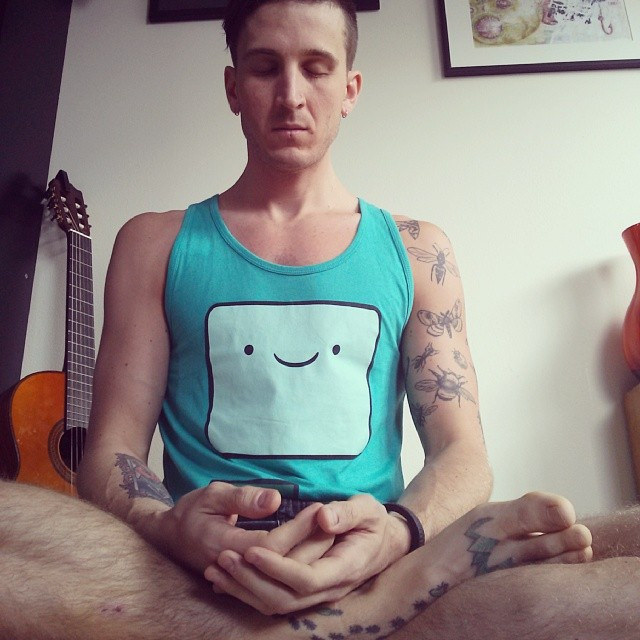
“The flowering of love is meditation.” ~ J. Krishnamurti
Mindfulness is available to all of us, but because our lives are busy and we are often distracted, we rush through our days in a state of mindlessness.
By cultivating a regular practice of meditation, mindfulness begins to seep into our “post-meditation” or informal practice as we move through our daily lives and interactions.
According to Buddhist teacher Stephen Batchelor:
“Meditation can be practised in two main ways: either by stopping and cultivating concentration and enquiry in a systematic way using the tools of awareness: breath, sensations, sounds, thoughts and meditative questioning; or by paying attention to life moment to moment without grasping as we go about our days. Both methods are needed for the cultivation of meditation to become an art. The first method helps us to become peaceful, still and bright. The second method anchors our awareness and makes the meditation permeate the whole fabric of our life.”
The following techniques are four examples of literally thousands of different meditation techniques out there. They make for a strong foundation of practice, both formal and informal. See which one resonates with you most and start there. Choose a time of day that works best for you and a place in your home that is clean and inviting. I suggest beginning with five to 10 minutes of stillness practice (seated or standing) using the same technique for at least a week before trying out another one.
Breath Awareness
Sit or lie down in a comfortable position. Relax your body, consciously releasing tension from all the muscles and letting your weight sink into the earth.
When the mind wanders, gently bring it back to the present moment by feeling your breath entering and leaving your body. The beauty of the breath as a mindfulness anchor is that it is always there, all our lives. Let the breath be natural. Just observe how it is. Over time, as you sit tall and practice, your breath will deepen.
“Breathing in, I know that I am breathing in.
Breathing out, I know that I am breathing out.”
~ Thích Nhất Hạnh
The breath is always with us. The opportunity for present moment awareness is always here. The practice of breath awareness is one that can easily be transmuted into brief pauses sprinkled throughout the day: upon waking up, before eating a meal, on the morning/afternoon commute, or just before falling asleep.
Gazing
Close your eyes halfway and soften your gaze. Relax your jaw and forehead, neck and shoulders. Gaze at the object of your choice. Suggested focal points: a dancing candle flame; fluffy clouds drifting across the sky; a yantra or mandala; an image of a guru, saint or master; the eyes of a beloved; your own eyes in the mirror.
Set a timer and start with three minutes, adding an extra minute to your practice each day. If the gaze hardens or wanders away from its focal point, return the gaze and continue until your timer goes off. Sit for another moment with your eyes closed and notice the quality of energy in your mind, body and heart.
“Soon you will become aware of an ocean all around. Then you will see that you are also just a wave; your ego is just a wave. Behind that ego, the nameless, the one, is hidden. Only waves are born, the ocean remains the same. The many are born, the one remains the same.” ~ Osho
Visualization
Close your eyes and envision a perfectly still lake at sunrise, its surface a flawless mirror. A thought passing through the mind is like a pebble dropping into the lake, creating a ripple of concentric circles and then calming back down again.
Sometimes, there may be a barrage of ideas, memories, fears and feelings creating waves and leaving you distracted in their wake. Over and over, with patience and persistence, come back to the still lake, back to your pure awareness and the ground of being.
“If you can visualize the whole of spring and see Paradise with the eye of belief, you may understand the utter majesty of everlasting Beauty. If you respond to that Beauty with the beauty of belief and worship, you will be a most beautiful creature.” ~ Said Nursî
Meditation on Sound
Listen. Secrets are told by the silence. Sit, stand or recline. Be still, like a statue. Listen to the whisper of your breath. Listen to the sounds, nearby and further away.
Sounds are always occurring in the present moment. Open your ears to the subtlest of sounds. They are your anchor.
“We do not create nor imagine sounds. We wait for them to come to us. Any sounds will do—the roar of a car, the barking of a dog, the twittering of a bird. We listen attentively to any sounds that might occur with a non-grasping attitude. We open up to the music of the world and of life. We do not name, conjecture or identify the sounds. We just listen as widely and openly as we can at the sounds themselves. If there are no sounds we just listen to silence and its special hum.” ~ Stephen Batchelor
Try this technique in different settings. Practice it with natural sounds, indoors, outdoors, alone, in a crowd. It’s sometimes fun to add in a favorite song or symphony, too.
Of course, no matter what technique you employ, the mind will play tricks and create all sorts of reasons for you to avoid, quit or postpone meditating. And when you do find the willpower to sit, alone and quiet, the mind will play more games with you. The mind is incredibly sneaky! Emotions can be like powerful waves, knocking you to your hands and knees. Likewise, you can go through periods of boredom and numbness. The key is to just keep practicing, staying open, working with what is.
“Meditation is one of the greatest arts in life—perhaps the greatest, and one cannot possibly learn it from anybody, that is the beauty of it. It has no technique and therefore no authority. When you learn about yourself, watch yourself, watch the way you walk, how you eat, what you say, the gossip, the hate, the jealousy—if you are aware of all that in yourself, without any choice, that is part of meditation.” ~ J. Krishnamurti
Author: Michelle Margaret Fajkus
Image: Trevor Ellestad/Flickr
Editors: Catherine Monkman; Emily Bartran





Read 0 comments and reply